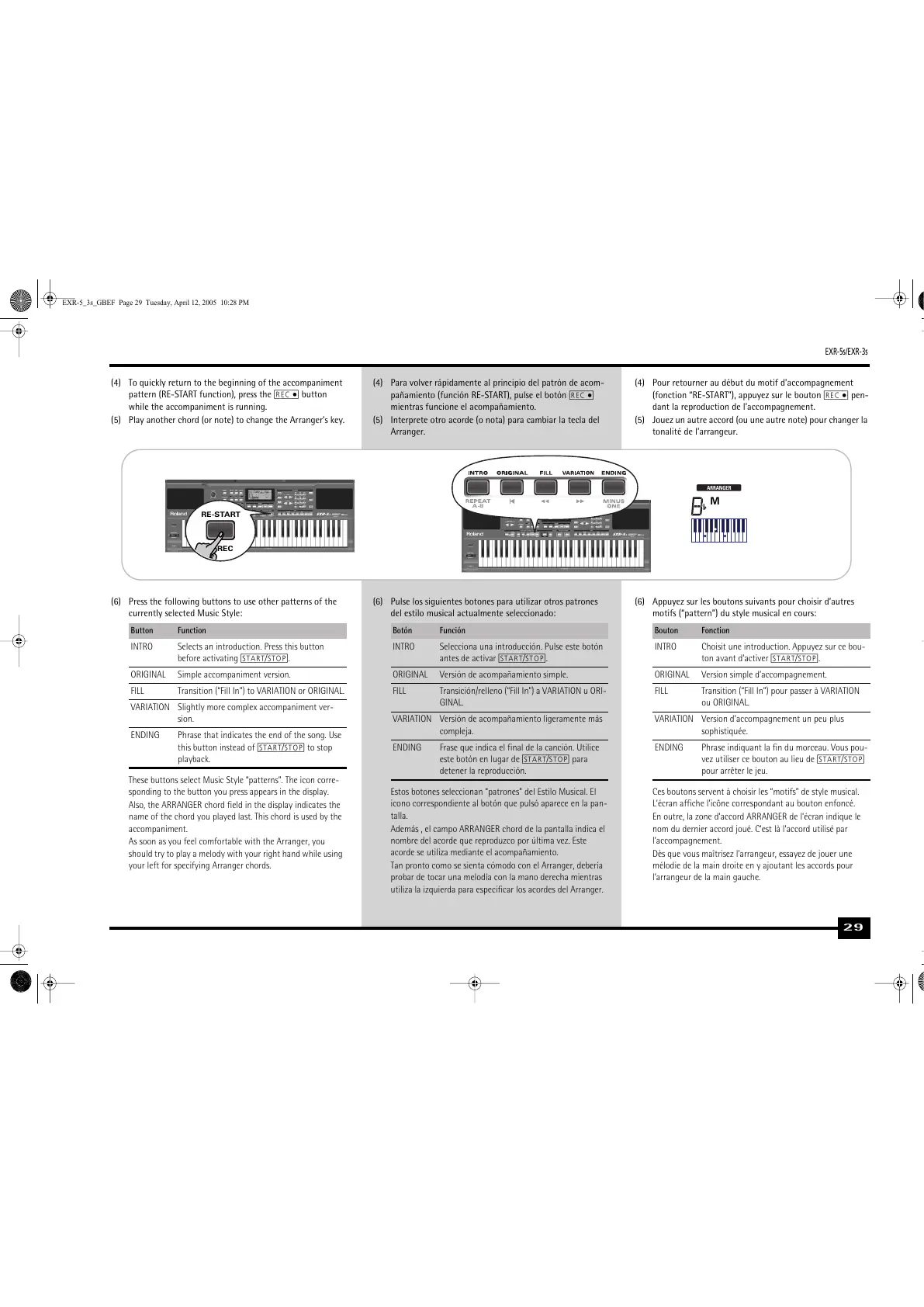EXR-5s/EXR-3s
29
(4) Para volver rápidamente al principio del patrón de acom-
pañamiento (función RE-START), pulse el botón [REC≈∏]
mientras funcione el acompañamiento.
(5) Interprete otro acorde (o nota) para cambiar la tecla del
Arranger.
(6) Pulse los siguientes botones para utilizar otros patrones
del estilo musical actualmente seleccionado:
Estos botones seleccionan “patrones” del Estilo Musical. El
icono correspondiente al botón que pulsó aparece en la pan-
talla.
Además , el campo ARRANGER chord de la pantalla indica el
nombre del acorde que reproduzco por última vez. Este
acorde se utiliza mediante el acompañamiento.
Tan pronto como se sienta cómodo con el Arranger, debería
probar de tocar una melodía con la mano derecha mientras
utiliza la izquierda para especificar los acordes del Arranger.
Botón Función
INTRO Selecciona una introducción. Pulse este botón
antes de activar [START÷STOP].
ORIGINAL Versión de acompañamiento simple.
FILL Transición/relleno (“Fill In”) a VARIATION u ORI-
GINAL.
VARIATION Versión de acompañamiento ligeramente más
compleja.
ENDING Frase que indica el final de la canción. Utilice
este botón en lugar de [START÷STOP] para
detener la reproducción.
(4) Pour retourner au début du motif d’accompagnement
(fonction “RE-START”), appuyez sur le bouton [REC≈∏] pen-
dant la reproduction de l’accompagnement.
(5) Jouez un autre accord (ou une autre note) pour changer la
tonalité de l’arrangeur.
(6) Appuyez sur les boutons suivants pour choisir d’autres
motifs (“pattern”) du style musical en cours:
Ces boutons servent à choisir les “motifs” de style musical.
L’écran affiche l’icône correspondant au bouton enfoncé.
En outre, la zone d’accord ARRANGER de l’écran indique le
nom du dernier accord joué. C’est là l’accord utilisé par
l’accompagnement.
Dès que vous maîtrisez l’arrangeur, essayez de jouer une
mélodie de la main droite en y ajoutant les accords pour
l’arrangeur de la main gauche.
Bouton Fonction
INTRO Choisit une introduction. Appuyez sur ce bou-
ton avant d’activer [START÷STOP].
ORIGINAL Version simple d’accompagnement.
FILL Transition (“Fill In”) pour passer à VARIATION
ou ORIGINAL.
VARIATION Version d’accompagnement un peu plus
sophistiquée.
ENDING Phrase indiquant la fin du morceau. Vous pou-
vez utiliser ce bouton au lieu de [START÷STOP]
pour arrêter le jeu.
(4) To quickly return to the beginning of the accompaniment
pattern (RE-START function), press the [REC≈∏] button
while the accompaniment is running.
(5) Play another chord (or note) to change the Arranger’s key.
(6) Press the following buttons to use other patterns of the
currently selected Music Style:
These buttons select Music Style “patterns”. The icon corre-
sponding to the button you press appears in the display.
Also, the ARRANGER chord field in the display indicates the
name of the chord you played last. This chord is used by the
accompaniment.
As soon as you feel comfortable with the Arranger, you
should try to play a melody with your right hand while using
your left for specifying Arranger chords.
Button Function
INTRO Selects an introduction. Press this button
before activating [START÷STOP].
ORIGINAL Simple accompaniment version.
FILL Transition (“Fill In”) to VARIATION or ORIGINAL.
VARIATION Slightly more complex accompaniment ver-
sion.
ENDING Phrase that indicates the end of the song. Use
this button instead of [START÷STOP] to stop
playback.
ARRANGER
M
RE-START
● REC
EXR-5_3s_GBEF Page 29 Tuesday, April 12, 2005 10:28 PM

